The Complete Guide to Carolina Barbecue
Embark on this trail like Carolina barbecue specialists — sit back, have a smoke, trust the process, take your time, and enjoy.
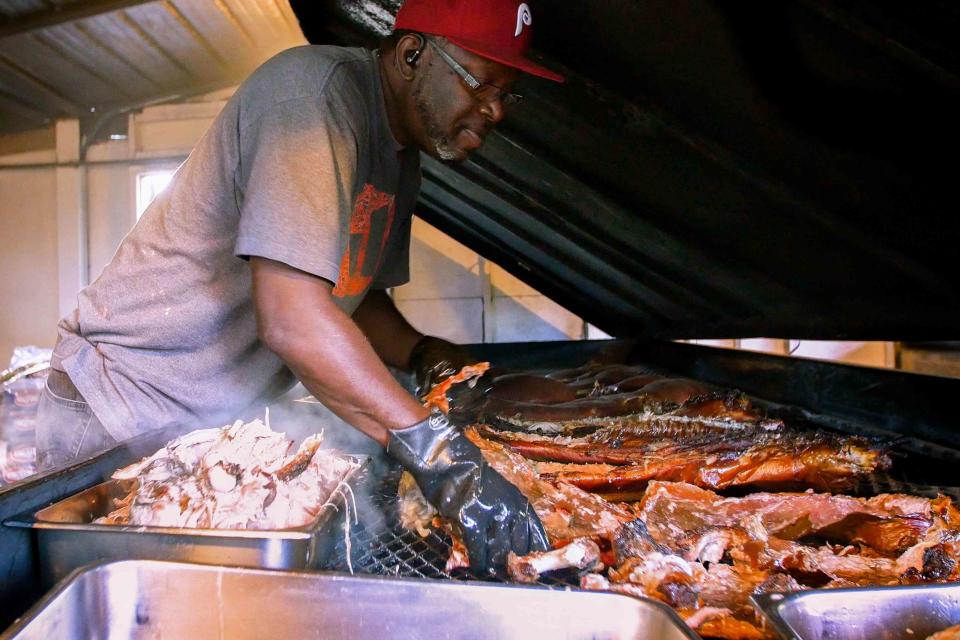
courtesy of visitgreenvillenc.com
Barbecue is a noun, an adjective, a verb, a cultural token held closely to the hearts of Carolinians, who grew up eating diligently and meticulously smoked pork, brushed in a tangy sauce by neighborhood pitmasters.
In fact, North and South Carolinas' distinct barbecue styles have become so deeply intertwined with identity that they’ve fostered a homegrown pride, establishing loyalist regions as if they were devout sects, delineated not by trivial notions like say, religion or politics, but by how to cook and dress a pig properly.
Although, there is one front pitmasters across state lines can unite on: If it’s not cooked, low and slow, with wood — hickory, oak, red oak, or pecan in the Carolinas — “it ain’t barbecue,” as written on a sign for all to see at Ayden, North Carolina’s famed Skylight Inn.
Low and slow pit-smoking basks the pork in a tunnel of wood smoke, with the meat’s fat dripping down, then rising, wafting, and infusing back into the hog for 10-plus hours. That’s the kind of art-meets-science happening in the pit.
Related: The Best Barbecue in Every State
That concept takes on a few nuanced shapes along a Carolina barbecue trail.
Starting in Eastern North Carolina, whole, snout-to-tail hogs cook directly over wood coals and come brushed in the Great Mother Sauce — vinegar and pepper. Some joints handpull the vinegar-laced meat into fork-tender, ropelike bites, while others finely or coarsely chop the whole pork. Textures aside, each bite should be a whole mouthfeel of marbled meat, cut with a zingy sauce. The side that reigns supreme over all sides is slaw, and on the east side, it’s a finely chopped white slaw, with a base of mayo and a splash of vinegar.
Western North Carolina — Piedmont or Lexington style — smokes a lean pork shoulder, tenderized directly over wood embers or neighboring the coals for an even cook. Here, they pledge allegiance to a tomato-based sauce, which bites with acid but is softened by an umami, sweeter ketchup flavor. That same tomato-base is the lifeblood of Western North Carolina’s red slaw.
Moving southbound, a mustard-based mop dominates the Midlands of South Carolina. And there’s usually a whole amalgamation of vinegar and tomato dips bottled up on the table. A proper barbecue tour would be remiss without South Carolina’s iconic side of barbecue hash — a pork gravy-meets-chili stew ladled over rice. All-inclusive of the pork if you know what I mean.
Related: A Guide to the Essential Regional American Barbecue Sauces
Both states agree on a “meat plus three” philosophy — a popular phrase in the South's lexicon for good reason. Something cornmeal-crunchy like hushpuppies, something creamy like mac 'n' cheese, and something green (but just barely) like collards should accompany the ‘cue.
And of course, barbecue without banana pudding or fruit cobbler to finish is melancholic. Well, maybe that’s dramatic but rules are rules.
Despite some of these crucial and some, quite frankly, hair-splitting differences, traditional Carolina barbecue is more alike than not: It’s no-frills and red checkered baskets and sweet tea in styrofoam. It’s wood piles stacked eagerly for their place in the pit and embers aglow in the dark. It's a warm welcome and a dizzying aroma of smoke. It’s a pitmaster’s craft — uncompromising patience, intuition, and more patience.
Now, the above is a traditional view of Carolina barbecue. This is what many generations of locals would call barbecue. But, as tradition goes, it will inevitably be challenged.
And that doctrine-shattering innovation is happening in the Carolinas as Texas brisket, Mexican spices, and Chinese smoked duck enter the scene, thanks to a wave of younger chefs and pitmasters who take tradition on an ingenious, illuminating ride. Enter the world of new-school barbecue, and you’ll find some cross-cultural fusion, a little booze (typically nowhere to be found in a barbecue restaurant), and meats besides pork — and even, dare I say, smoked vegetables — that shift our perception of what barbecue can be.
Fear not, barbecue loyalists. Inviting a little change and marrying regional styles is exactly how some of the most notable flavors and techniques have taken shape in the first place, especially within barbecue. Immigrating Germans introduced the almighty mustard and sausages. In fact, the very foundation of southern barbecue as we know it comes from Taíno Indigenous communities' technique of cooking and preserving meat low and slow at a small distance above a fire. When Spanish colonizers brought pigs and the Taíno smoked and spritzed them with lime juice, barbecue was born. From there, this roasting ritual came rolling into the mainland and down into the Carolinas, where 16th-century Black communities honed the art of roasting whole hogs.
So, as veteran barbecue joints still remain busier than most other spots in town, one might ask why change something that’s endured for so long? Others might ask, why not?
Here’s a mosaic of classic and contemporary spots to ask that very question.
B’s NC (Greenville, North Carolina)
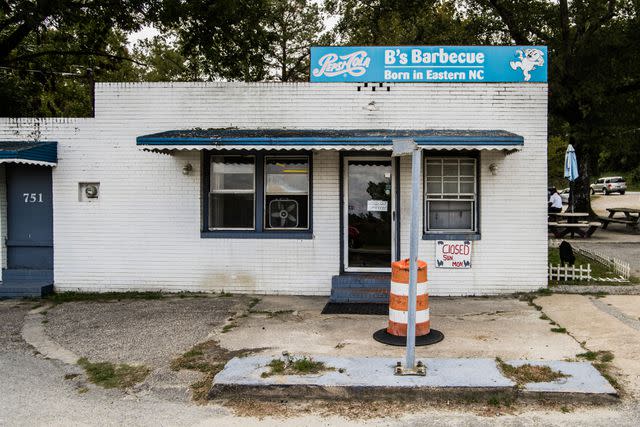
courtesy of visitgreenvillenc.com
B’s is home to everything-but-the-squeal aka whole hog barbecue in a charmingly rundown former gas station. Tailgating college students and local zealots swear by B’s hand-chopped pork shrouded with a veil of vinegar and red pepper sauce. The crispy-skin chicken here is worth a mention, too. It’s hard not to wonder what magic happens in the unseen hours to make the chicken fall off the bone and the skin crunch like it does. The time between the order window and pick-up window (takeout only) is a liminal space, as hungry crowds await their down-home food — corn sticks, boiled potatoes, and a tart mayo-based coleslaw. Queue up sunrise-early to get those sought after ribs for an afternoon feast (or realistically, a 10 a.m. feast) because B’s sells out. It’s cash-only with most everything under $13 — no fancy credit stuff here.
Lexington Barbecue (Lexington, North Carolina)
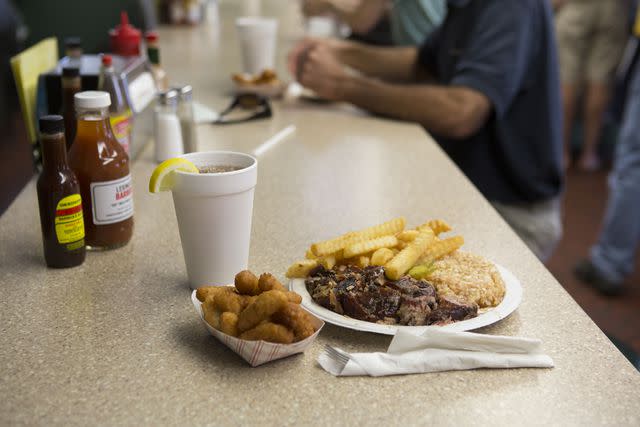
April Greer for The Washington Post / Getty Images
Somehow, when the door opens at 10 a.m. every day except Sunday at Lexington Barbecue, the booths are already packed. Trays of pork freckled with red chili flakes line the tables alongside a ketchup-based dip, piping with steam, in a styrofoam cup. The server Allison makes a good point: Why compromise hot pork with cold sauce? Rumor has it that no one was allowed inside the kitchen when owner Wayne Monk concocted that sauce, and the ratio is still kept secret today. Regulars get the smoked turkey sandwich; extra helpings of the hushpuppies with a shattering, cornmeal crunch; and the pork shoulder skins that crisp up like chips. This is a family-run restaurant with Wayne’s son Rick (and other longtime staff that feel like family) roasting shoulders in the back starting at 5 a.m. Get lucky and this crew may hand you a plate of peach cobbler with a sugar-coated pie crust.
Red Bridges Barbecue Lodge (Shelby, North Carolina)
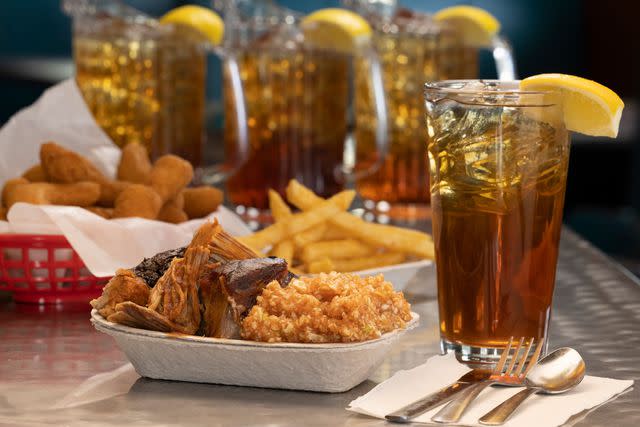
courtesy of Red Bridges Barbecue Lodge
Current co-owner Natalie Ramsey learned the fine art of hospitality and hickory-smoking a pork shoulder from her grandmother Lyttle Bridges, the matriarch who worked 12-hour days here until she was 80 years old. Here, the pigs don’t get a pre-season; it’s simply smoke and time. While barbecue puritans might order chopped, the thick strands of pulled pork are extraordinarily smoky and fork tender, particularly when dipped in the signature Bridges sauce — a pleasantly pucker-inducing ketchup and vinegar blend. For a little extra depth, get the skin-on coarse chop brown. The slaw here — oh, the slaw — is finely, finely chopped white cabbage that bursts with acidity and a zing of horseradish-like heat. Locals swear by Bridges’ generously sized, curved Dixie Crystal hushpuppies. While the ‘cue here remains loyal to classic Piedmont-style, Ramsey proudly calls it “Shelby Style. There’s nothing like it.”
Union Barbecue Truck (Charlotte, North Carolina)
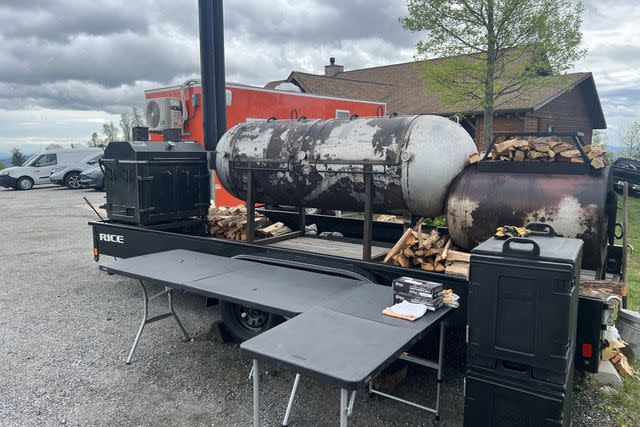
Holden Sasser / Union Barbecue Truck
As a middle schooler, Holden Sasser cooked whole hogs on his uncle’s farm. In college at UNC Chapel Hill, he organized whole-hog events to raise money for organizations like No Kid Hungry. Seven years later, he’s got his own truck bopping around Charlotte that, despite the owner’s Carolina roots, slings a new-school Tex-Mex barbecue menu from a two-person team. The house pickles cut right through the brisket, lime zest coats the fan-fave pork ribs, and a punchy salsa taquera sauces up a mile-high pulled pork sandwich. The secret weapon for this stunning pork is heritage pigs from Peculiar Pig regenerative farm in Dorchester, South Carolina. Union Barbecue Truck's sides blend whimsy and heartiness, from a smoked sweet potato with pepitas to a jicama salad. The dessert, not so Tex-Mex, but so very necessary to save room for, is the Big Deborah, a gargantuan oatmeal crème pie.
Lewis Barbecue (Charleston and Greenville, South Carolina)
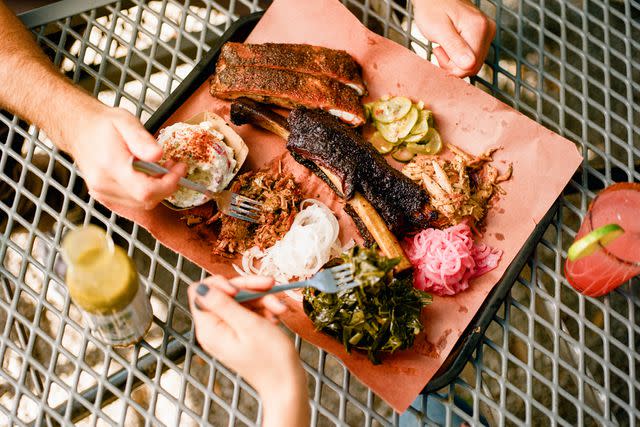
Lizzy Rollins / Courtesy of Lewis Barbecue
Whether in Greenville or Charleston, South Carolina, dining at Lewis is a bit more of a spectacle than some of these down-home places. Before even opening their mouths to order, guests will be handed a sample of salty-savory brisket or offered a bite of the tallow fat fries, decadent and dense. Owner John Lewis certainly has a central Texan flair at the core of his craft barbecue, but reality is, it’s in the Carolinas now. The pork shoulder and beef brisket is doused in a mustard and pickle juice mop and hugged with a hush-hush rub to steep in its own fatty glory as any good North Carolina barbecue does. The buttery brisket, smoked with a blend of red oak, hickory, and white oak, boasts a deep-hued, crusty bark formed from five hours of cold smoke and 15 more of high-temperature smoke. Other must-gets include the corn pudding and the Sancho — a fiery little sandwich with pulled pork and housemade hot guts sausage.
Scott’s Bar-B-Que (Hemingway, South Carolina)
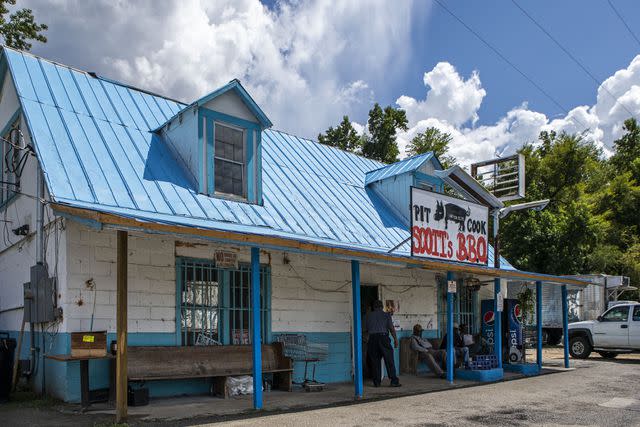
Alex Holt for The Washington Post / Getty Images
If road tripping through country roads and then some is your thing, Scott’s is the destination. One could almost blink and miss it if it weren’t for that striking Carolina blue roof. This shack is where the ever-celebrated Rodney Scott, now a James Beard Award-winning chef, learned to cook a whole hog from his parents. The menu at Scott’s is just a few basics; they don’t need much else but the rough chop or fine pull of whole hog cooked right over hickory, oak, and pecan embers. This barbecue, mopped with a pepper-tinged vinegar sauce and served straight from the pit as service begins, hasn’t cut any corners since the 1970s. If the drive out to Hemingway seems daunting, Rodney Scott has bona fide whole hog cooking at Rodney Scott’s Whole Hog BBQ in Charleston, Birmingham, Nashville, and Atlanta, where that same Carolina blue color lines the exterior of each. Like most things in barbecue, there’s always a nod to the past.
King BBQ (Charleston, South Carolina)
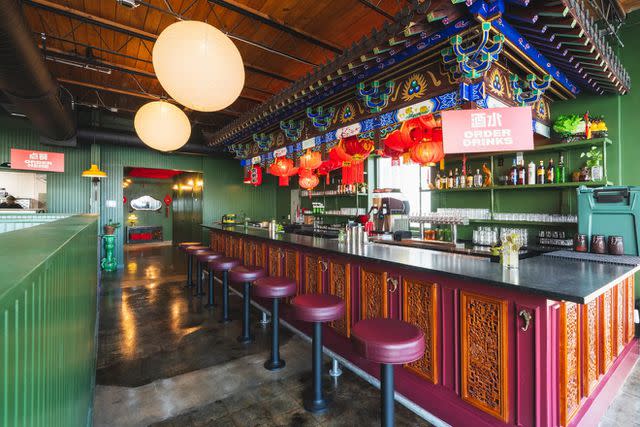
courtesy of King BBQ
If you’re looking for traditional barbecue — this is nothing of the sort. This is Carolina barbecue redefined and refreshed, spiked with Szechuan, scallion, and soy. At King, chef Shuai Wang, a guru of Chinese cuisine, combines forces with pitmaster Brandon Olson, who brings a finesse for hog-cooking thanks to his Lexington roots and time at Home Team BBQ in Greenville. The result: an eclectic, personality-rich restaurant with lantern-lined green walls and an equally as playful Chinatown barbecue meets Carolina ‘cue menu. Instead of a conventional vinegar mop for the pork, King blankets the pork butt in a Szechuan and Thai chili vinegar sauce, which can come chopped, on a sandwich, or draped across noodles or rice. The bestselling pork ribs glean with cha shao, and regulars ask for the Chinese hot mustard Q with a wasabi sting to it. The menu’s primary meats — pork and duck — are generously pre-seasoned and smoked over oak. Traditional barbecue joints don’t typically serve alcohol, but here there are cocktails, which are another compelling reason to visit this new-school barbecue joint in Charleston. Specifically, the nori-infused, pickled-pepper-spin on a martini.
For more Food & Wine news, make sure to sign up for our newsletter!
Read the original article on Food & Wine.

